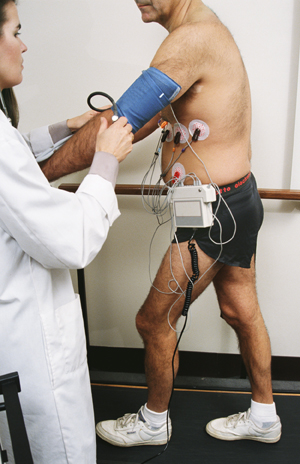Exercise Stress Test
Exercise Stress Test
An exercise stress test shows your heart's response to exercise. Your healthcare provider often gives you this test to evaluate the blood flow to your heart, your exercise tolerance, your heart's pumping pattern at different levels of work, or the presence of a heart rhythm disturbance. The test records your heartbeat while you walk on a treadmill or ride a stationary bike. The test can be done in a hospital, a test center, or your healthcare provider's office. The test is also called a stress electrocardiogram (ECG/EKG). This test is only appropriate in those who have the ability to participate in exercise and have no contraindications such as risk of falls.
Before your test
Tips to being prepared before your test include the following:
Be sure to mention the medicines you take and ask if it’s OK to take them before the test.
Avoid food and drinks containing caffeine, as instructed by the healthcare provider.
Don’t eat, drink, smoke, or have any caffeine for 3 hours before the test.
Don't exercise immediately before the test.
Getting ready
Tips to getting ready for your test include the following:
Wear comfortable walking or running shoes.
Wear a shirt or a blouse that you can remove easily. You may be asked to remove your clothing from the waist up. Women may wear a gown.
During your test
Here is what to expect at the time of the test:
Electrodes (small pads) are placed on your upper body and a blood pressure cuff on your arm. These are used to monitor your heartbeat and blood pressure during and after the test.
You are shown how to use the treadmill or bike.
You are then asked to exercise for several minutes. Expect the exercise to be easy at first. It will slowly get harder, with an increase in speed and incline every few minutes. This happens to monitor your heart as it is forced to work harder.
Exercise as long as you can, or until you are asked to stop.
Be sure to tell your healthcare provider if you feel any of the following:
Chest, arm, or jaw pain or discomfort
Severe shortness of breath
Fatigue
Dizziness
Leg cramps or soreness
Faintness
Palpitations
After the test
Here is what to expect after your test:
You can resume your normal activity, unless otherwise instructed.
The results are sent to your healthcare provider.
Be sure to keep your follow-up appointment to learn the results of this test and what they mean.
Report any symptoms
Be sure to tell your healthcare provider if you feel:
Chest, arm, or jaw discomfort
Severe shortness of breath
Fatigue
Dizziness
Leg cramps or soreness
Faintness
Palpitations
Your next appointment is: ____________________
Updated:
March 20, 2017
Sources:
2010 American College of Cardiology Foundation/American Heart Association Guideline for Assessment of Cardiovascular Risk in Asymptomatic Adults. Greenland P. Circulation. 2010;122(25):s584-636., Exercise ECG testing: performing the test and interpreting the ecg results. UpToDate, Exercise Stress Testing in Women. Kohli P. Circulation. 2010;122:2570-80.
Reviewed By:
Fetterman, Anne, RN, BSN,Gandelman, Glenn, MD, MPH
